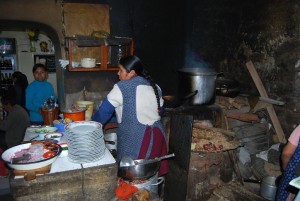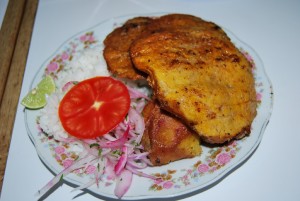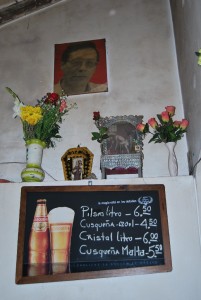Cuzco’s Traditional Food: Picanterías

A simple table in a room pulsing with the uneven beat of huaynos and the moan of yaravies, indigenous song forms of Peru, tall glasses sit on a table as steaming plates are set down. The room is filled with families and groups of friends conversing and eating, while the street outside has no more room for anyone else to park. This is Saturday at the Picantería las Manuelitas (Urbanización Tawantinsuyo) in Cuzco.
Though the nearby city of Arequipa claims the picantería as much its own as the white volcanic rock from which the city is built, Cuzco also has a long tradition of picanterías. People will tell tourists that if they want to know Cuzco they need to go to its picanterías and chicherías.
The difference between the claims of Arequipa and the Cuzco reality hinges on those two words. Some people say the picantería is typical of the volcanic southern city, while chicherías are typical of Cuzco. But this is a difference without much substance, made more so each can have something to claim as its own from a broadly shared southern Andean tradition.
The two are similar, but the chichería focuses on serving chicha with small dishes of food to accompany it, while the picantería emphasizes grilled meats and accompaniments (such as soup, potatoes, and llantán–hot sauce). Both serve food, both have chicha, and both are wildly popular. Their difference is only a matter of emphasis.

And both have a strong history in Cuzco. The name picantería is Spanish for a place that serves and makes picantes. In ordinary Spanish this is not a noun but only an adjective for something spicy, like the related word “piquant” in English.

The English borrowed the Indian term “curry” to have a noun to speak about spicy dishes. And in Mexico they have the word “mole”, as well as the word chile, each to speak to dishes made with peppers and sauces made from them.
In Peru this switch from Spanish adjective to noun happens without much comment. But underlying it is a different history from that of Spain and its language.
Here the root word is uchu, like the Mexican chilli, a word for hot peppers. But since hot peppers were the preferred and almost ubiquitous spice, uchu became a word that closely approximates a general term for “food”.
As a result, in Peru and neighboring countries you find dishes named for their ingredients under the broader label picante. You can try a picante de fideo (a picante of pasta), a picante de lisas (a picante of olluco), and so on.
But, the dishes are not necessarily spicy, though hot peppers often play a small role in their construction. Rather they are savory and nourishing.
However, these picantes are generally found in the home, or markets, or on street corners where women bring insulated pots to sell quick lunches and suppers to workers and other passersby. These picantes are different from the ones meant to be special, to celebrate being out and about or some special event.
This latter kind of picante emphasizes meat. But in a picantería one does not find a fine chateubriand or ribeye. Rather one finds more ordinary cuts of meat and lots of organ meats.

A picantería, as a result, is a place that serves popular food, food designed for the ordinary person and as a result also popular.
Although there is daily traffic, on weekends the picanterías fill. Everyone has their own favorite since picanterías are found around the city and in its traditional neighborhoods. A few, such as Maria Angola, El Fogón, and an array on Nueva Alta street are also found in the colonial core.
Many neighborhood picanterías and chicherías do not have names on signs outside their doors. Instead, one can often see a red plastic bag affixed to a stick. This indicates that the place is a picantería.

In this, Las Manuelitas is no exception. Near the Church of Recoleta, just outside the colonial core, Las Manuelitas’ clients have given it a name. They call it Las Manuelitas because there used to just be one picantería there, run by the current owners’ mother and grandmother–since it has decades of existence and tradition.
But, after the owner’s death, her children inherited the family home–where the picantería is located, and the two daughters drew a wall through the middle of the picantería so each could have their same space.
People call it The Manuelitas, after a popular woman’s name, Manuela, to suggest both the former unity and present separation into two.

One enters, past the kitchen with its wood fired oven and grill to rooms with tables, decorated with posters of beer. A young woman points to a chalked board listing what dishes they have today. These include a thin, grilled beef steak, breaded beef udder, grilled chicken breast, baked trout, fried ribs, malaya (a local cut of beef), roast beef, oxtail stew, corn with cheese, grilled beefheart, and so on.
For Cuzqueños just the names of the dishes alone makes their mouth begin watering and their stomachs beg. These are traditional dishes, considered by locals to be typical because they are common in the City and region.

One can order chicha (corn beer) or frutillada (a strawberried chicha) to down with the meal. The woman in a blue frock first brings a basket of silverware along with a bowl of Cuzco´s ubiquitous green sauce llantán made from a local herb huacatay, bread, and rocoto peppers. Then she brings medium sized bowls of a plain beef broth. It is plain, that is until you taste it. Its deep taste concentrated from stewed meat and bones is anything but plain. Instead it is a rich brocade of flavor.
As you are sipping from your soup spoons the woman sets large glasses of chicha or frutillada in front of you, prompting you to lift them, offer a few drops to the earth mother, the pachamama, and then click glasses with your table mates while wishing each other “salud” or health.
At midday, the radio pulses with local music, but in the evening musical groups come to play for the picantería’s guests for tips.
When we went a blind guitarrist was sitting on a stoop outside the picantería having probably just performed. At the same time a seven-year-old boy named Oliver and a fifty-something man from an elite family but who is mentally challenged, called “difunto” or “dead one” watch cars, help people park in open spaces, and occasionally wash the cars down.

The picanterías, whether Las Manuelitas or another, are filled with local color and culture. In many, one finds traditional games people can play to entertain themselves, such as sapo (or toad) where one tosses coins to open holes or best to the toad’s mouth to compete with each other and to obtain luck.
Many restaurants in the tourist core may offer Peruvian cuisine, or typical food, but they cannot offer it with the color and culture of the picanterías. These truly are Cuzqueñan and day in and day out create life in this increasingly large city.




